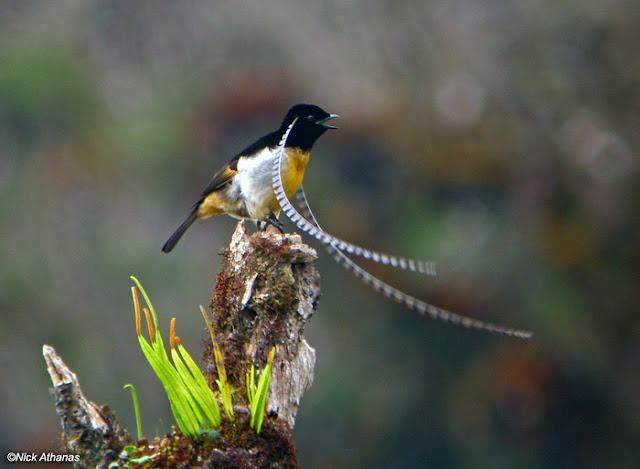King Of Saxony (Pteridophora Alberti)
The bird-of-paradise King-of-saxony (pteridophora alberti) is native to the rain forest regions of New Guinea. The species is distributed from the Weyland Mountains in Western New Guinea to the Kratke Range in Papua New Guinea at 1,400–2,850 meters above sea level, but primarily at 1,800–2,500 meters asl.
Descriotion
The adult King of Saxony Bird-of-paradise
is approximately 22 cm long. The male is black and yellow with a dark brown iris, black bill, brownish-grey legs, aqua-green mouth, with two remarkably long (up to 50 cm) scalloped, enamel-blue brow-plumes that can be erected at the bird's will. The unadorned female is greyish brown with barred underparts. The male's ornamental head plumes are so bizarre that, when the first specimen was brought to Europe, it was thought to be a fake.
is approximately 22 cm long. The male is black and yellow with a dark brown iris, black bill, brownish-grey legs, aqua-green mouth, with two remarkably long (up to 50 cm) scalloped, enamel-blue brow-plumes that can be erected at the bird's will. The unadorned female is greyish brown with barred underparts. The male's ornamental head plumes are so bizarre that, when the first specimen was brought to Europe, it was thought to be a fake.
Female P. alberti have off-white underbodies patterned with darker chevrons, while the tops of their bodies are grey-brown in color. There are also immature males that sport female-style plumage. Females weigh 68 to 88 g.
Mating system
Courtship displays and nesting of Pteridophora alberti take place between September and April. Only one egg is laid per clutch; it is not known if more than one clutch is attempted per season. Incubation of this single egg appears to last longer than 22 days. Young P. alberti hatch and remain altricial for a period of time before fledging, but nestling and fledging periods are unknown. However, most species in the birds of paradise family fledge within 20 to 30 days of hatching. Age of sexual maturity is also unknown for this species, but sexual maturity usually takes 1 to 2 years for most birds of paradise.
Behaviour
Adult males are territorial. The male guards its territory from perches placed in the tops of tall trees, and from these perches sings to compete with males in neighbouring territories. Moulted head-plumes in good condition are sought by male
Archbold's Bowerbirds for use as decorations, and in turn collected from the courtship bowers by humans.
Food Habits
To find more visit-wikipedia
Food Habits
King-of-Saxony birds-of-paradise are mainly frugivores. Approximately 80% of their diet consists of fruit; they tend to favor green fruits, especially false figs above most other fruits. They are also known to eat insects. Adult males forage mainly in the upper canopy, but females and males with female-plumage have been spotted in all levels of forest growth.
To find more visit-wikipedia
Category: Bird-Of-Paradise











0 comments